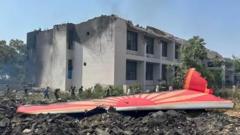In a harrowing incident, Air India Flight 171, a Boeing 787 Dreamliner, crashed shortly after takeoff from Ahmedabad headed for London, resulting in the deaths of 241 passengers aboard and 19 individuals on the ground, with only one survivor. The recently released preliminary report by India’s Air Accident Investigation Bureau (AAIB) has caused a stir, offering limited information while leaving key questions unanswered.
One of the most contentious points raised in the AAIB report is the mention of two fuel cut-off switches that were moved to the 'cut-off' position mere seconds after takeoff, leading to engine failure. Though the engines were later restarted, it was deemed too late to avert disaster. The report included a reference to communication between the pilots regarding the cutoff but lacked a detailed transcript of their conversation. This omission has spurred speculation about possible intentional actions by one of the pilots, a claim that the Indian Commercial Pilots' Association has vehemently criticized as irresponsible and damaging.
The AAIB's 15-page document serves as an initial factual summary, mandated by international protocols, but investigators express concern over its selective disclosure of information. Some industry experts claim that the current narrative appears to omit vital context, particularly regarding the technical functioning of the aircraft's systems before the crash.
Added to the complexity, the report references a 2018 FAA safety bulletin regarding potential issues with fuel cut-off switches, while noting that Air India didn't conduct required inspections. However, the FAA reaffirmed that this issue did not compromise safety, stirring additional confusion and speculation about the crash's causes.
Former air accident investigators and aviation consultants voice disappointment over the report's vagueness, suggesting that the presented details could imply a narrative without explicitly stating it. Critical elements, such as the actual conditions inside the cockpit leading up to the crash and the timeline of switch manipulation, are notably absent.
As investigations unfold amid public scrutiny, it remains uncertain when firm conclusions will be drawn. The final report is expected to be completed within a year, but history shows that comprehensive investigations often require much longer to reach resolution, leaving the bereaved families and the aviation community hoping for clarity amid the current uncertainty.
One of the most contentious points raised in the AAIB report is the mention of two fuel cut-off switches that were moved to the 'cut-off' position mere seconds after takeoff, leading to engine failure. Though the engines were later restarted, it was deemed too late to avert disaster. The report included a reference to communication between the pilots regarding the cutoff but lacked a detailed transcript of their conversation. This omission has spurred speculation about possible intentional actions by one of the pilots, a claim that the Indian Commercial Pilots' Association has vehemently criticized as irresponsible and damaging.
The AAIB's 15-page document serves as an initial factual summary, mandated by international protocols, but investigators express concern over its selective disclosure of information. Some industry experts claim that the current narrative appears to omit vital context, particularly regarding the technical functioning of the aircraft's systems before the crash.
Added to the complexity, the report references a 2018 FAA safety bulletin regarding potential issues with fuel cut-off switches, while noting that Air India didn't conduct required inspections. However, the FAA reaffirmed that this issue did not compromise safety, stirring additional confusion and speculation about the crash's causes.
Former air accident investigators and aviation consultants voice disappointment over the report's vagueness, suggesting that the presented details could imply a narrative without explicitly stating it. Critical elements, such as the actual conditions inside the cockpit leading up to the crash and the timeline of switch manipulation, are notably absent.
As investigations unfold amid public scrutiny, it remains uncertain when firm conclusions will be drawn. The final report is expected to be completed within a year, but history shows that comprehensive investigations often require much longer to reach resolution, leaving the bereaved families and the aviation community hoping for clarity amid the current uncertainty.





















